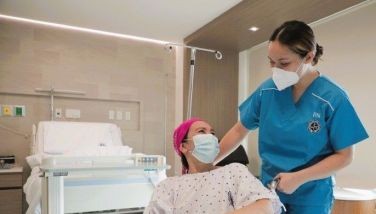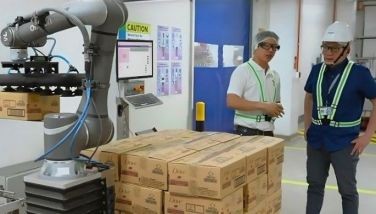Boracay after a storm

September 16, 2001 | 12:00am
 Just our luck to plan a post-summer weekend at "the best beach in the world," when the vagaries of the rainy season were already upon us. The fortuitousness worked both ways, however, even if not until the last minute were we assured that it was a go.
Just our luck to plan a post-summer weekend at "the best beach in the world," when the vagaries of the rainy season were already upon us. The fortuitousness worked both ways, however, even if not until the last minute were we assured that it was a go.
Typhoon Feria had wrought havoc up north, and forced the cancellation of some flights down south. The Friday we took our seats on an Asian Spirit flight (direct, no-frills, no-nonsense – meaning no camaraderie games played onboard to disturb a nap), we learned it was the first to take off for Caticlan after the storm.
I had heard of how Boracay was vastly different during the season of the habagat – that time of year from July to as late as November when monsoon rains were often induced by persistent winds from the southwest. Even when there was no rain, the southwesterlies would pound the famous White Beach that was Boracay island’s staple scene, as promenade, bathing and ogling arena.
True enough, our arrival at Caticlan airport ushered in the differences wrought by a shift in season. Instead of the quick hop to the regular jetty, the motorized tricycles had to conduct the portage to an alternative and rather distant docking station. This meant a twenty-minute ride through a rough and muddy road, where the counterflow demanded a deferential accord determined by the availability of space on the edge of the narrow trail.
Getting into a pumpboat for the ferry ride to Boracay meant paying up for a piggyback ride to keep footwear and pantlegs dry. One wonders of course why a proper wharf can’t be erected at this alternative docking site, since it often turns into the take-off point from the mainland during habagat, when the waves are deemed too strong to risk the direct crossing toward Boat Stations 1 to 3 on White Beach.
A pleasant surprise however was that the ferry crossing seemed to take no more than a jiffy. The hop from the mainland’s endpoint to the backside of Baracay – its northeast coast – was hardly noticeable. Soon most of the passengers were landed at the first stop. Since we were headed for Pearl of the Pacific close to Boat Station 1 at the far end of Boracay, the ferry ride took another coast-hugging ten minutes to get to the docking site at Bagabag.
From there it was another tricycle ride to our intended resort, passing through the so-called Main Road, which still showed ample evidence of the onset of the typhoon season.
This road, which has become familiar to Boracay habitues as the artery that ran past the backdoors of establishments fronting White Beach, showed signs of increasing deterioration. The regular concrete breaks up toward the far end, and is taken over completely by a harrowing dirt road that’s gutted, potholed and flooded in parts.
It was no consolation to hear that further concreting would follow the completion of an upgraded sewerage system on one side of this two-tricycle-lane road. That we finally saw a work crew in place at some point the next day was no great assurance, either.
On the beach, the magic of Boracay still beckoned, much as the surrounding ambience was indeed starkly different from the fabled scenes of summer. For one, constant were the strong winds that roiled the surf and whipped up all along the beach front. Gone were the placid waters of the summer months, when children could wade in for several meters and enjoy the gentle slope under clear blue-green water.
This time it was a different experience, with body-surfing the obvious temptation as high waves rolled in to slam wader or swimmer. The sun was weak, the waters a deep blue spliced constantly by froth. An element of danger forewarned anyone struggling to battle the incoming sheets of curling wave, with a strong undertow pushing west.
The Marian-adorned rock that poeticized this end- stretch of White Beach looked even more enchanting from a misty distance. Bright colors of what appeared to be pendants were attached to its craggy, elongated form. Upon closer inspection, the buntings turned out to be plastic bags and shreds of all sorts of material that had strapped themselves to the rock.
All along White Beach, the frontages of resort establishments appeared to be contending for a prize for best approtech application of windbreakers. Sawali walls, woven palm fronds, large bamboo poles serving as gridwork for extensive blue and green nettings, an array of plastic sacks, and other ingenious combinations of native cum nylon materials endowed the beach front with a surreal look. It was as if all the resort owners had tacitly engaged in a humongous installation art display.
Absent were the usual al fresco protrusions imposed by certain establishments on parts of the beach. And where these stayed on a setback, there were no takers for the outdoor cafe amenities, what with the protective enclosures penning these off from a beach view.
Lounging chairs were still brought out on an individual basis, as there was still a modest number (far from a crowd or horde!) of off-season visitors welcoming the opportunity for a mild tan. A massage was definitely an A-1 experience, although laying a large towel on the sand became unviable due to the constantly whipping wind.
Still and all, the wandering masseuses did their business with regularity, even as the off-season informality allowed them to stray from their Boat Station quarters to peddle their services directly.
Aye and aieee! The relaxation of rules also allowed a veritable army of other vendors to wreak havoc on tourists’ notions of private idyll. Every minute a lounger on the shore would be approached by a hawker of pearls and puka-shell adornments, assorted fresh catch, rice cakes, taho (!), and woodcraft replicas of sea vessels brought in weekly from Guimaras and peddled by viajeros up and down White Beach.
The large, detailed galleons and schooners were a good buy for foreign tourists, at only P2,500 – and likely to be haggled down – for the largest model at four feet long, replete with small bulbs to light up the cabins. Or one could settle, as we did, for a hundred-fifty-peso outrigger with a couple of sails. As a Boracay souvenir, it goes a long way in a pond back home.
The intrusions are of such frequency however that a beachcomber can only feel safe by plunging back into the mini-maelstrom that was the sea, or by acceding to an hour of massage. Bathed in coconut oil and kneaded gently while prone or supine on a chaise lounge, one then enjoyed temporary protection from the entreaties of other services-and-goods suppliers.
The offers of a boat – a real pumpboat for snorkelling, diving, and island-hop excursions – took the prize for persistence. It seemed every native, from waiter to tricycle driver to regular tout, to your own cherished masseuse, knew someone who had a pumpboat that could be scheduled the next day.
We settled for our masseuse’s husband as boatman, and the full day on Saturday allowed us a fine, sun-drenched series of hops to secluded beaches, caves and coral gardens, the lunch highlight of which was good seafood at the resto on Puka Beach.
Resort amenities took over as dark fell, but not until after the ritual constitutional up the wide stretch of White Beach for yet another splendiferous sunset. Then one had a choice of Thai, Greek, Mediterrranean or Korean cuisine at any of the restaurants enjoying a walking path from Boat Station 2 onwards. Here too the kids can play Counterstrike or surf at an Internet stall, so that the island truly becomes the center of the world, terrorists and all.
It was with some disappointment that we realized how our resort had obviously taken a sorry turn due to obvious management woes. It couldn’t just have been the off-season, for surely a chlorinated and spruced-up swimming pool wasn’t exactly unviable even at the height of a storm. Maintenance seemed dispirited, and it was only on Sunday when the flotsam and jetsam that had littered the frontage in Typhoon Feria’s wake saw a clean-up crew hauling off the debris for burning. The lawns were unkempt, the plumbing questionable, the service extremely tardy, such that a coffee cup placed on the hallway took forever to vanish.
Otherwise, cable TV and a lone firefly calling for a mate on the balcony enhanced the evenings in what purported to be paradise.
Sunday it was back to an overcast sky, and eventually the long tricycle trek toward Boat Station 1, where the pumpboats were back in operation for the crossing to the mainland. Yet here again, no proper wharf was evident, so that the piggyback carriers were in full operation.
It doesn’t quite leave a good memory of an idealized island – especially after seeing all the trash in the paths and alleys, all the mud and flooded potholes on Main Road – to have to be carried above the waters for one’s departure.
Whither goes Boracay? In peak season or off, the future seems one of unmitigated commercial expansion, without the requisite obligations also being put in place. DOT Chief Dick Gordon really ought to sit down everyone involved to ensure that the tag of "best beach in the world" can still be defended for a few more years.
In any case, this recent visitor after a storm can content himself with the more pleasurable memories of the island in times past. Perhaps now I can only wistfully regard the sailboat souvenir idling rather pacifically afloat in our small pond.
BrandSpace Articles
<
>



















